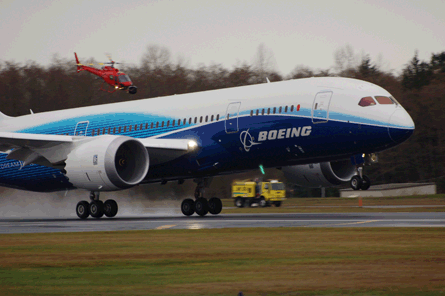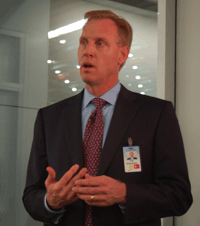While the most visible part of the 787 programme is centred on the start of flight-testing the largely composite twin-engined jetliner, Boeing continues to evolve the Dreamliner's production system while tackling the challenges that lie ahead for the base of global suppliers.
Concurrent flight-testing and production are not new to modern aircraft production, yet the impact of design changes discovered during flight-testing can reverberate back through the already built aircraft and those in process.
"I'm incredibly interested in the flying of the airplane. What's relevant to us is the pull signals [from Boeing] and the changes that come back around from flight test," said Jeff Turner, chief executive of Spirit AeroSystems on 3 December at the Credit Suisse First Boston Aerospace & Defense conference.
FORWARD FUSELAGE
Spirit is responsible for fabrication and integration of the forward fuselage of the 787, which includes the flightdeck, as well as the pylons and the fixed and movable leading edges of the wings.
Turner is cautious about the prospect of widespread design changes emerging from flight-testing as Boeing learns more about the capabilities of the aircraft. Even before the first aircraft took to the skies on 15 December, incorporating those changes has been an enormous challenge for Boeing's dispersed supply chain, which as the programme has progressed has agonised over when and where those design changes should make their way into aircraft.
 |
|---|
© Jon Ostrower/Flightglobal |
Negotiations over change incorporation has resulted in fully completed sections of the aircraft being shipped to Everett, only to see significant portions of the work later removed and updated at final assembly slowing the flow of the line.
Beyond answering "where and when" the design changes are incorporated, the question of responsibility for paying for the associated design work and incorporation has been anything but uniform during the 787 programme's two years of amassed delays.
Retrofits to aircraft as a result of certification or flight test "is not a novel idea to the industry", says Turner, weary of the potential cost associated with the extent of an unknown number of likely changes.
Those modifications, Turner and other suppliers say, are inevitable as flight-test programmes reveal areas requiring redesign, but to what extent are these necessary and how should the responsibility be shared?
Across the programme, first-tier suppliers recently incorporated a comprehensive package of design changes starting with Airplane 13, delivered to final assembly in Everett in November. The update, mainly focused on the wiring system, dubbed "net change 5" or NC5, allowed Boeing's structural suppliers to harmonise their designs, reducing the need for further re-work after arrival at final assembly.
The road to selecting Airplane 13, programme sources say, was an arduous back-and-forth between Boeing and its top-tier suppliers to determine the point of incorporation of the newest changes to the 787's design.
Buck Buchanan, Spirit's chief operating officer, says of NC5: "We anticipate that being the last major wiring change - we hope."
EXPANDED OVERSIGHT
The March 2008 buyout of Vought's 50% share of Global Aeronautica was the first major outward step allowing Boeing to expand its reach inside Charleston, bringing a direct oversight to the centre fuselage facility to better manage the staff on-site.
Ultimately, the acquisition of Vought's share of the 787's aft fuselage in July, as well as the complete ownership of Global Aeronautica, has allowed Boeing to work within its own operational structure, setting its own timetables for change incorporation while more effectively managing the cost of those changes, say those working directly in manufacturing operations.
The 22 December announcement of the acquisition of the remaining 50% of Global Aeronautica marks the fourth major industrial change at the company's North Charleston site, reflecting an incrementally growing role that initially began as increased oversight and has culminated in the complete ownership and operation of the company's East Coast production base.
 |
|---|
© Jon Ostrower/FlightglobalShanahan: too challenging? |
Boeing has transformed its own role on the programme, initially fabricating only the tail of the 787 to fabricating the aft fuselage, as well as integrating the centre, representing two-thirds of the 787's fuselage.
But the question remains as to whether Boeing can leverage the initial ambition of its global supply chain and deliver unprecedented cost savings during the production of its all-new jetliner.
"We don't doubt that the technology has already been respected," says Carter Copeland, aerospace analyst at Barclays Capital. "It's actually building it and building it profitably that remains to be seen."
While managing the new expanded facilities at Global Aeronautica and Boeing Charleston, the company will be investing significant resources to increase production flow through the final assembly line inside Building 40-26 at the company's Everett facility, while establishing the planned "surge" assembly line inside Building 40-24 to enable a 10-aircraft a month rate by the end of 2013.
Furthermore, Boeing's selection of North Charleston as the future home to its second 787 final assembly line, the first new commercial facility the company has built since the 1960s, is an estimated $750 million investment.
NEW ASSEMBLY LINE
Boeing faces the challenge of setting up a new final assembly line on the South Carolina site that will initially build three 787s a month, allowing Everett to slow to seven aircraft a month. The Charleston final assembly line is set to be operational by July 2011, with its first 787-8 delivered in the first quarter of 2012.
Aravind Melligeri, co-founder and chairman of Quest Global, the engineering consultancy and manufacturer whose aerospace production includes 787 landing gear components it supplies to Messier-Dowty, remarked before the first flight that if Boeing were to rush to full output "the supply chain would be scrambling. We've all been sitting back waiting for this aircraft to fly."
He added that a rate of six a month would be more manageable than the planned 10 aircraft a month.
Boeing defends its plans, saying that it "not rushing to achieve rate". It adds: "Our stated schedule is 10 a month by late 2013. There's an orderly plan in place to meet that goal. Boeing and its partners are working to that plan and are in regular contact to ensure production system health."
Boeing closed 2009 with 16 787s assembled, a number that includes two ground test airframes, six flight-test aircraft, two of which are now flying, plus the first eight production aircraft. Parts for the 17th aircraft had already begun to arrive as the year closed.
The company has been slowly ramping up since the middle of 2009, increasing the deliveries from structural partners with the June arrival of aircraft seven, the first production 787.
Boeing has been receiving parts for each 787 about twice per calendar month, with that number expected to rise early in 2010 as the rate accelerates around mid-February, programme sources say.
As Boeing pushes forward with its ambitious production ramp-up spread across its global suppliers, the company is continually aware of the lessons learnt and now applied.
Pat Shanahan, vice-president of airplane programmes at Boeing and former chief of the 787 programme, said following the 787's first flight: "How you choose your schedule is a big deal. Technically there weren't any obstacles we couldn't overcome. We were running a fast race and we probably shouldn't have made it as challenging. We didn't have to make it as challenging."
Source: Flight International























